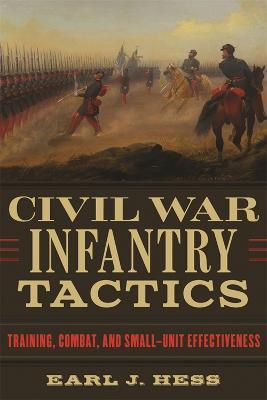Civil War Infantry Tactics: Training, Combat, and Small-Unit Effectiveness

Civil War Infantry Tactics: Training, Combat, and Small-Unit Effectiveness
For decades, military historians have argued that the introduction of the rifle musket-with a range five times longer than that of the smoothbore musket-made the shoulder-to-shoulder formations of linear tactics obsolete. Author Earl J. Hess challenges this deeply entrenched assumption. He contends that long-range rifle fire did not dominate Civil War battlefields or dramatically alter the course of the conflict because soldiers had neither the training nor the desire to take advantage of the musket rifle's increased range. Drawing on the drill manuals available to officers and a close reading of battle reports, Civil War Infantry Tactics demonstrates that linear tactics provided the best formations and maneuvers to use with the single-shot musket, whether rifle or smoothbore.
The linear system was far from an outdated relic that led to higher casualties and prolonged the war. Indeed, regimental officers on both sides of the conflict found the formations and maneuvers in use since the era of the French Revolution to be indispensable to the survival of their units on the battlefield. The training soldiers received in this system, combined with their extensive experience in combat, allowed small units a high level of articulation and effectiveness. Unlike much military history that focuses on grand strategies, Hess zeroes in on formations and maneuvers (or primary tactics), describing their purpose and usefulness in regimental case studies, and pinpointing which of them were favorites of unit commanders in the field. The Civil War was the last conflict in North America to see widespread use of the linear tactical system, and Hess convincingly argues that the war also saw the most effective tactical performance yet in America's short history.PRP: 372.00 Lei
Acesta este Prețul Recomandat de Producător. Prețul de vânzare al produsului este afișat mai jos.
334.80Lei
334.80Lei
372.00 LeiLivrare in 2-4 saptamani
Descrierea produsului
For decades, military historians have argued that the introduction of the rifle musket-with a range five times longer than that of the smoothbore musket-made the shoulder-to-shoulder formations of linear tactics obsolete. Author Earl J. Hess challenges this deeply entrenched assumption. He contends that long-range rifle fire did not dominate Civil War battlefields or dramatically alter the course of the conflict because soldiers had neither the training nor the desire to take advantage of the musket rifle's increased range. Drawing on the drill manuals available to officers and a close reading of battle reports, Civil War Infantry Tactics demonstrates that linear tactics provided the best formations and maneuvers to use with the single-shot musket, whether rifle or smoothbore.
The linear system was far from an outdated relic that led to higher casualties and prolonged the war. Indeed, regimental officers on both sides of the conflict found the formations and maneuvers in use since the era of the French Revolution to be indispensable to the survival of their units on the battlefield. The training soldiers received in this system, combined with their extensive experience in combat, allowed small units a high level of articulation and effectiveness. Unlike much military history that focuses on grand strategies, Hess zeroes in on formations and maneuvers (or primary tactics), describing their purpose and usefulness in regimental case studies, and pinpointing which of them were favorites of unit commanders in the field. The Civil War was the last conflict in North America to see widespread use of the linear tactical system, and Hess convincingly argues that the war also saw the most effective tactical performance yet in America's short history.Detaliile produsului










